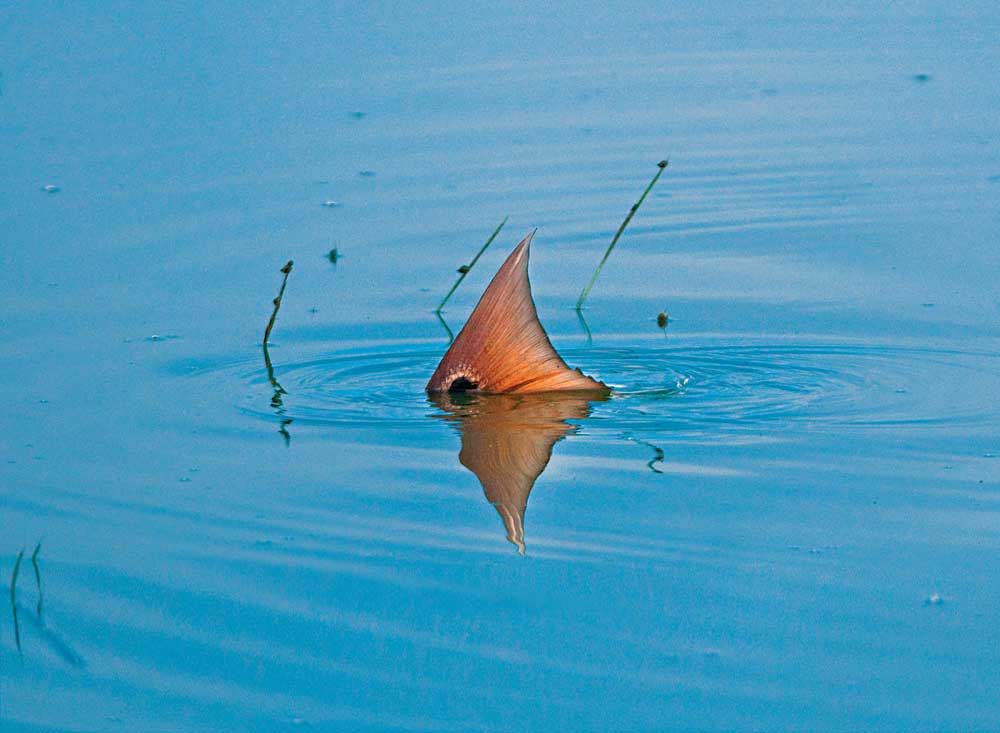
I got the call at about 10 p.m. on a cold winter night. I realize that a low in the mid-30s during January isn’t considered cold by many fly-fishermen, but in Charleston, South Carolina, anything below 50 degrees will keep the waters pleasantly devoid of angling pressure. My fishing partner, Capt. Jeremy Mehlhaff, was on the line, and he’d had an open day with an early-morning low tide, sunny skies and light winds. We met at the launch a few hours after he phoned and quickly splashed the boat into the predawn fog and headed away from the city lights and many steeples that define the Holy City’s skyline. Our mission was fly fishing for redfish in areas considered off the beaten path.
After a few harrowing minutes of running through the waning darkness and a pea-soup fog, we decided we should pole a bank and wait for a little more visibility before continuing on with any speed. There was now enough light to see disturbances on the glassy surface within a cast in any direction, and we were in just a few inches of water, so any decent-size redfish would likely give away its position.
It was only a minute or two before we saw the first wake subtly pushing across the flat, and Mehlhaff wasted no time getting the little black Toad a few feet in front of the fish. For a few tense seconds, the wake disappeared and we wondered if the fish was wise to our presence, but finally there was an eruption of water and mud as the fish flared its gills to suck in the fly. A few minutes later, it was boat-side for a quick photo shoot in the morning haze before being released back into the chilly water.
The sun soon burned away the fog, and we removed layers as the temperature climbed into the 50s. As we continued to explore, we found a variety of schools in the crystal-clear water. There were a few groups of 20 to 30 that were extremely spooky and blew up at the tiniest hint that they were not alone. We encountered a massive school of 200 fish practically being chased out of the water by a pod of vicious dolphins. We managed to pick off a fish or two in these less than optimal conditions before moving on again.
Our last stop of the day, which we had scoped out a few weeks earlier on Google Earth, was the most rewarding. Several hundred redfish from 6 to 10 pounds were moving up and down a grass edge in a foot or two of clear water, flashing as they fed on glass minnows. After admiring the view for a few short moments, we took turns feeding them our favorite redfish flies for an hour or so until they decided we had outstayed our welcome.

Redfishing in Charleston, South Carolina
Charleston and the surrounding Low Country support a vivacious year-round redfish population, offering visiting fly-fishermen and local feather chuckers alike a shot at epic sight-fishing on any given day. Don’t get me wrong, there are definitely days when they make you work for an eat. Some days they are just as tough to feed as downtown Islamorada, Florida, bonefish. On the other hand, there are days when they will smash even the most poorly presented flies. Most days lie somewhere in the middle, with a few fish blowing up at the subtle flash of a line in the air and a few rewarding your efforts by charging the fly and inhaling it back to their crushers.
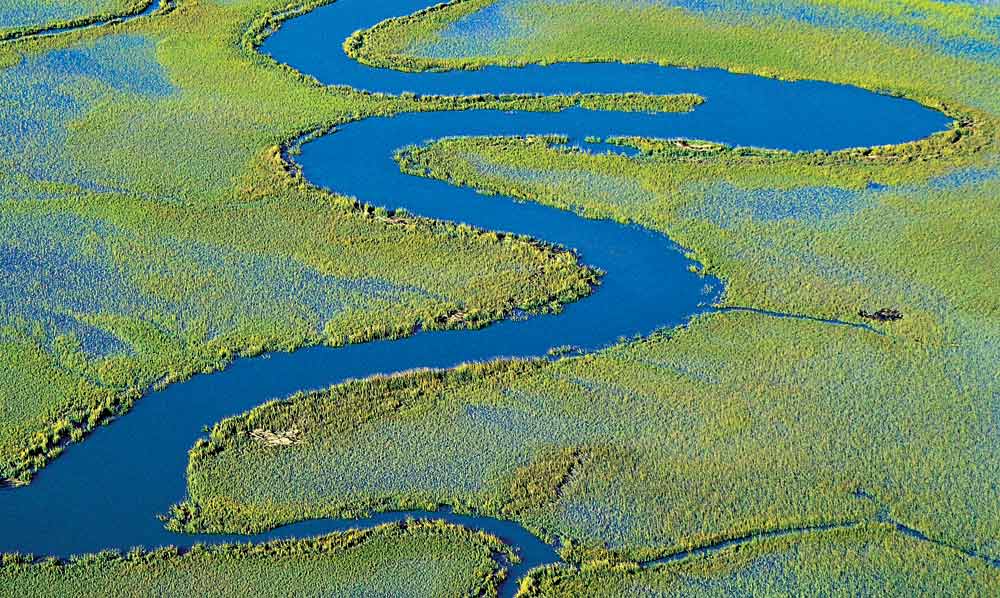
South Carolina’s favorite game fish are blessed with a labyrinth of waterways surrounding Charleston to call home. The waters are varied, and redfish can be found in a multitude of different habitats and situations. The breeders live in deep harbor channels, in the big water off the beaches and farther offshore, and they are generally targeted with bait and heavy spinning gear. A few persistent fly-fishermen venture offshore in the spring and fall and search for the occasional school that turns the surface into a frothing copper frenzy where any large fly will not go unnoticed for long.
However, most redfish in Charleston are targeted in their formative years, before they head offshore to create the next generation. They grow quickly and remain in the shallows for about two years, and at about age 3, they move to deeper waters. Every now and then, a bull redfish can be found in the shallows, hanging with its younger brethren or snacking on treats from its youth, but in general, the skinny-water targets top out at 12 to 15 pounds.
While the water around Charleston can be very clear, most of the time it is not. In order for sight-fishing to work in dingy water, the fish must be shallow, and Charleston redfish are normally happy to oblige. On lower tidal stages, redfish can be found in water barely (or not even) covering their backs year-round on mud flats in large bays and oyster-filled basins, or on flats that line the edges of rivers and the Intracoastal Waterway. They can also be found in surprisingly tiny feeder creeks that fan out into the marsh in every direction from the larger bodies of water. Often they will remain in these creeks until almost every drop of water exits on the falling tide, belly-crawling across the barely covered pluff mud. When the tide returns, they hold at its edge, following the advancing water back toward and eventually into the Spartina grass.
You certainly have the opportunity to find redfish on any day of the year in skinny water, but the fish behave in ways that are much more conducive to fly-fishing, and just plain fun to watch, at certain tides and times during the seasons.
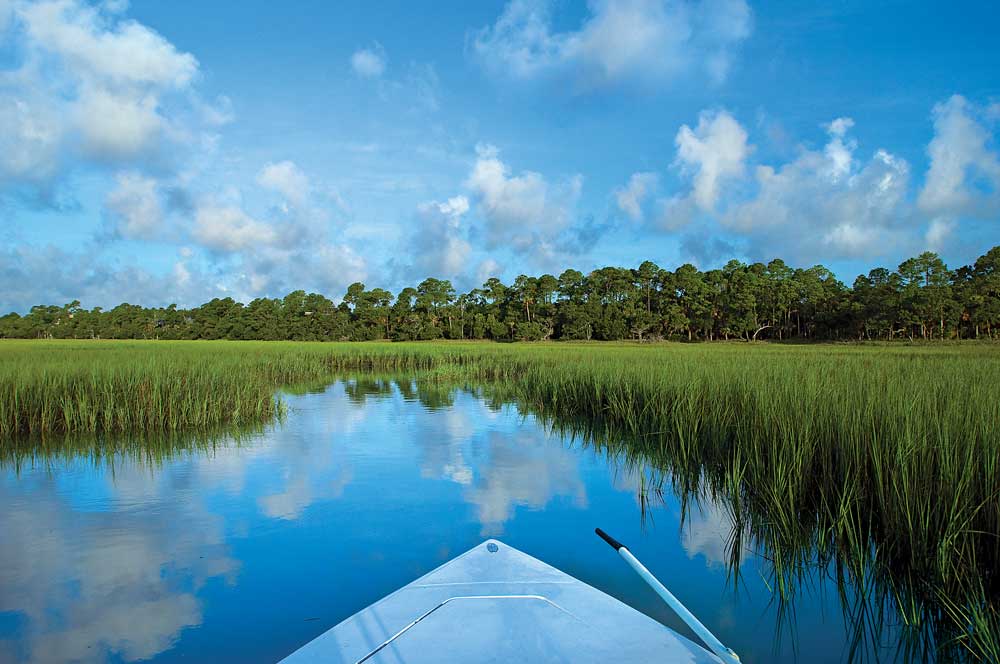
Charleston Redfish in the Summer
Starting around May, when you begin to see shrimpers trawling offshore, and continuing through summer and into October or November, Low Country redfish will push into the Spartina grass with the rising tide. High tides here typically range from 4½ to seven feet, and every few weeks when the spring tides arrive, highs over six feet flood hard-bottom grass flats, which hold huge populations of one of redfish’s favorite foods — fiddler crabs. Redfish push onto these flats and spread out to hunt, and local anglers follow. Redfish can be seen exposing their tails and backs at various times, but the summer is when the true tailing action occurs. Between the exposed tips of bright green grass, copper tails subtly slice the surface or clumsily wave in the air, splashing as the fish struggle to pin a crab to the bottom or suck one out of its burrow.
Because their minds are occupied, tailing redfish often can be approached pretty easily and fooled into eating a well-placed fly. But they also can be very spooky when the water is clear and the wind is light. You can lead cruising fish by several feet to avoid spooking them, but active tailers can pose a problem in this department. When they are in full headstand mode, they are distracted, making noise and kicking up mud. They are looking for food that is close by, which means you should place the fly close to the fish.
Most flats likely to have tailing fish are accessible only by boat. Once there, you can wade if you like, although I prefer the stealth and elevated platform of a well-poled skiff. Walk-to flats do exist, but are closely guarded secrets that are seldom betrayed, even with Charleston’s famed Southern hospitality. A few hours of scouting on Google Earth or Bing Maps, followed by some trial and error (and muddy shoes), can sometimes lead you to a gold mine. While flats with short grass are generally wadable, venturing too close to tall grass will likely cause frustration since the bottom in these areas is generally very soft mud.
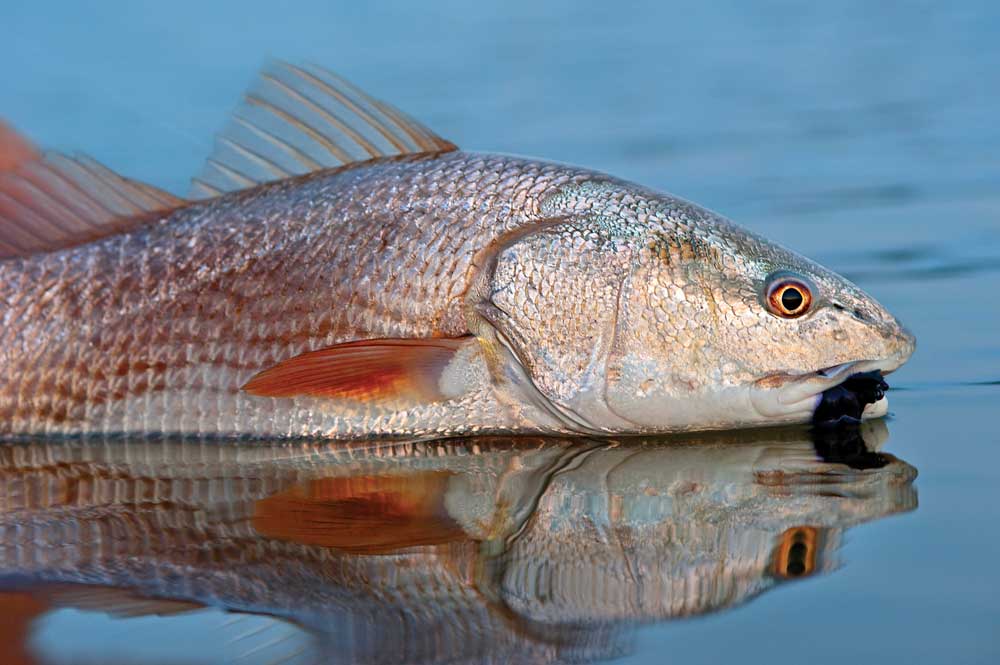
Redfishing Tips for the Fall
During the summer, prey for the redfish is abundant: crabs, mullet, menhaden, mud minnows and shrimp. Early in the summer, shrimp are tiny and may make a good meal for rat reds, but the big boys seek larger prey. By the end of the summer, the larger shrimp become a large portion of the redfish’s diet. During low tides, shrimp congregate into the shallowest parts of mud flats in an attempt to avoid the schools of growing redfish. As the reds push down these shorelines, shrimp can be seen frantically jumping out of the water in front of the fish’s wake.
But it’s not that easy being a shrimp. Taking to the sky alerts other mortal enemies, and soon gulls and egrets arrive. The sight of a dozen waking and tailing redfish pushing down a bank, with shrimp skittering in every direction and into the beaks of hovering gulls, is enough to get your blood pumping, but let’s not forget why we are here. These fish are gluttonous and fattening up on shrimp for the winter and will likely gobble up a shrimp imitation if you can get it out in front of them.
The best shrimping activity occurs from August through November, with prime time at sunrise when the low tide is an hour or so after dawn. You can luck up on this kind of activity anywhere, but it seems to occur more regularly in shallow oyster-filled basins and bays. Scanning the horizon for concentrations of active gulls is a good practice this time of year, but you can’t run and gun in the shallow bays; you need to be patient and approach stealthily.
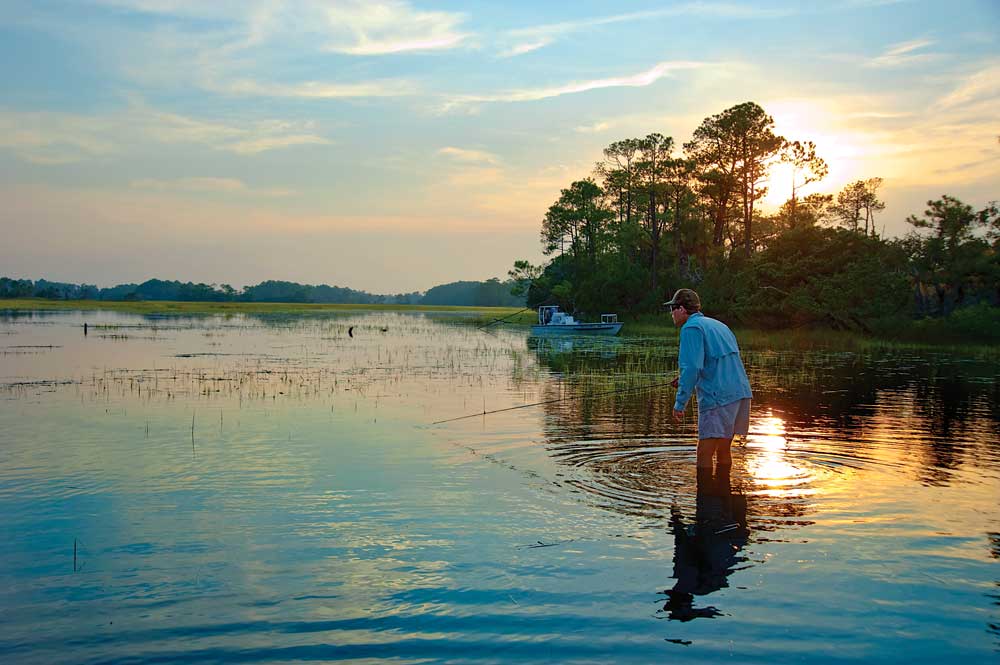
Winter Redfish in Charleston, South Carolina
As the temperatures continue to fall, the shrimp, mullet and menhaden push out of the estuaries, moving away from the bustle of the peninsula and past the harbor’s historic forts. The water begins to clear, and redfish gather into ever-growing schools. All spring and summer, dolphins have fed on the same migrating prey, and this exodus becomes an increasing problem for redfish as the season wears on. Pods of dolphins begin regularly corralling huge schools of reds into the shallows and occasionally pick off one or two. This is highly entertaining and can make schools easier to find in the winter, but reds are seldom happy when they are being targeted as prey.
With low tides and light winds, even unmolested winter schools can be spotted from a distance. Look for either large blocks of the telltale copper color or large areas of unexplained nervous water. While the fish are easier to find on a low tide, they usually will be happier and a bit easier to feed with a little water over their backs. Their metabolism slows down in the winter and they feed much less, so if you can find days or locations with warmer water temperatures, you will find more willing fish. A lot of wary eyes in clear water can mean challenging fishing, though. When the fish get spooky, lengthen and lighten your leader. At times, I’ve used leaders up to 12 feet that taper down to 10- to 12-pound fluorocarbon.
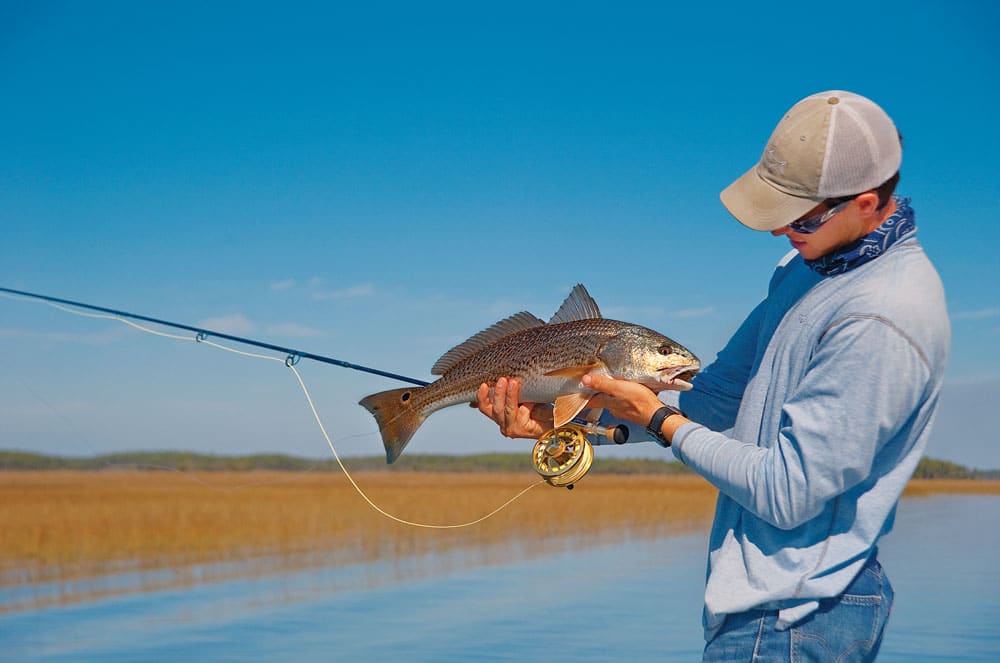
Charleston Brings Southern Hospitality
Charleston, South Carolina is well documented as a world-class destination, regularly winning prestigious travel awards and even earning the title America’s Friendliest City. With all the accolades, it is a wonder why this town is relatively unknown in the fly-fishing world. The sheer variety and quality of things to see and do here in the Low Country make it exceptionally well-suited to the angler whose fellow travelers may not be inclined to spend every waking hour on the water. For these folks, there is enough history, culture, shopping and culinary adventures to afford you a day or two of chasing redfish in the waterways where many of the greatest battles in our nation’s history were waged.
But don’t let your traveling partners stay landlocked. Charleston is an aquatic city, inundated by rivers, creeks and marshes. And while its compact downtown peninsula is the heart of the activity, you cannot fully appreciate Charleston without venturing out by boat to experience the soul of the Low Country.
Charleston is easy to get to and should be an easy sell to non-fishing companions or anyone who appreciates interesting history and rich culture. There are quite a few nonstop flights into Charleston’s small, friendly airport, and with Atlanta and North Carolina’s Charlotte both short hops away, flying in is quite easy. If you prefer to drive, Charleston is less than an hour from Interstate 95, so anywhere east of the Mississippi is manageable. Lodging and dining options abound in and around Charleston, and every travel style can be accommodated. There are numerous unique beach towns to stay and play in as well, and the whole area is littered with boat launches so you can fish close to wherever home may be during your stay.
There are plenty of guides around town; just make sure your guide is passionate about fly-fishing and has the boat, equipment and knowledge to put you on the fish.
Capt. Jeremy Mehlhaff: www.charlestonshallows.com
Lowcountry Fly Shop: www.lowcountryflyshop.com
Charleston Area Visitor Bureau: www.charlestoncvb.com
Fly Fishing Gear for Charleston, South Carolina Redfish
For the most part, redfish will be your main target when fishing Charleston. Seatrout, flounder and sheepshead are available all year while sharks, Spanish mackerel, bluefish and ladyfish are only summertime visitors inshore.
Rods and Reels: For nearly all situations, an 8-weight will get it done but throwing a 9-weight in the wind or a 7-weight on a super-slick calm day may can be advantageous. A big redfish can show you the backing and make your reel sing, but you don’t have to break the bank, as any decent medium- or large-arbor reel will work.
Lines: You will usually be fishing in skinny water, so a weight-forward floating line is all you will need. • Leaders: Use 9- to 12-foot leaders tapered to 12- to 20-pound fluorocarbon, depending on water clarity and the attitude of the fish.
Flies: Presentation is more important than fly choice, so I use patterns that land softly and have a lot of movement. I particularly like throwing small Toad patterns and EP Peanut Butter-style flies, and as in many other redfish destinations, it’s hard to go wrong with Clousers. Weedless flies are a must for fishing for tailers and can help when working around oysters and other obstacles.
License: If you are fishing with a licensed guide, you are covered; otherwise visit www.dnr.sc.gov /licensing.html.









